Edgar Rice Burroughs remains one of the most
commercially successful writers of the adventure-romance story in twentieth
century America. Burroughs wrote some seventy books whose sales now total
over one hundred million copies—no small achievement in literary history.
Burroughs’ talent in creating such memorable characters as Tarzan and John
Carter has created a legacy of adventure fiction that has remained long
after his death, and readers of the twenty-first century and beyond will
doubtless marvel at these same characters. Aside from these memorable characterizations,
Burroughs possessed a remarkable genius in creating totally imaginable
environments and societies that included the dark jungles of Africa, the
Martian landscape, and a point somewhere beneath the Earth’s crust.
Burroughs’ successful commercialization, his seemingly
timeless appeal to an excitement-oriented reading public, and his adroitness
in creating memorable characters should come as no surprise to fans and
foes alike, since the author really just follows a formula that has its
roots in the epic tradition. ERB, as his legions of admirers refer to him,
merely creates a hero, plunges this hero into a conflict of unknown proportions
with antagonists of strange and unworldly description, and adds a love
interest for his hero to further substantiate the notion of quest which
is so prevalent and central to the epic tradition. It is a formula that
has worked for nearly two thousand years and ERB merely repeated it over
and over again, thereby distinguishing his career as a master storyteller
with a collection of novels that highlighted the same heroes in a number
of stories.
The purpose of this unit will be to explore the worlds
of Edgar Rice Buttoughs through several of his works while paying particular
attention to the genius of his imagination and his ability to relate a
highly charged tale of adventure that includes multidimensional levels
of quest -- the same quests which formulate the epic tradition. Burroughs'
superhero protagonists constantly face challenges from other beings and
the environment, and even second-guess themselves. It is a further intention
of this unit that after having read and discussed a sampling of Burroughs'
work my students will be encouraged to explore some of their own quests,
both present and future, with the hope that they will be better able to
assess their strengths and weaknesses in the realization of their goals.
The selection of readings I have chosen as primary sources
for discussion in the unit include At
the Earth's Core, Tarzan
of the Apes, and The
Land That Time Forgot. I chose these selections from among the
many volumes Burroughs authored for a variety of reasons; I trust that
you who read this unit will concur with them, and be encouraged to implement
it in some fashion in your own curriculum. First, all three selections
are novels of quest that place their heroes in conflict with their environments,
other beings, and themselves. All the selections are of the high interest
level of reading while not being too difficult to read for the average
seventh or eighth grader. Each novel takes place on Earth (or, at least,
within Earth) so as to have some geographical relevance for my students.
All the novels have had film adaptations, thereby allowing anyone using
the unit to incorporate the films also, should they desire to expand the
scope of the unit with a discussion of the connection between literature
and film or merely to just entertain students as a follow-up activity.
Finally, the selections are all the first segments of their respective
series, which hopefully can direct the interested student to read further
and follow the adventures of his particularly favorite hero or storyline
to fruition.
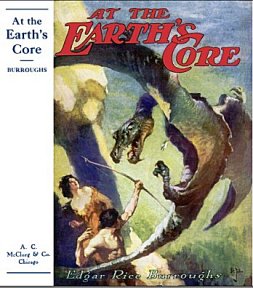 At
the Earth's Core, a narrative flashback by its central character, David
Innes, will be the highlighted work of the unit. This novel set in the
subterranean depths of Earth, Pellucidar, is a classic example of an adventure
story in the epic tradition. Moreover, it is as fine an example of quest
literature as has been written in the twentieth century, and would probably
make even Homer smile. The tale begins with David Innes, our young, handsome
hero climbing aboard the Iron Mole with its inventor, Dr. Abner Perry.
The Iron Mole is an invention which is in itself a symbol of man's quest
into the unknown, for it was invented to bore through the Earth's crust
in an attempt to discover just exactly what did exist within the confines
of the planet. David and Ferry attempt to perform a test bore; however,
the experiment goes awry and the two plummet deep beneath the Earth's crust
where they discover another world -- a world known as Pellucidar. Shortly
afterward the two men are taken prisoner by strange creatures of this inner
world. It is then that David meets the beautiful Dian -- a very human vision
of loveliness of this inner world who is also a prisoner.
At
the Earth's Core, a narrative flashback by its central character, David
Innes, will be the highlighted work of the unit. This novel set in the
subterranean depths of Earth, Pellucidar, is a classic example of an adventure
story in the epic tradition. Moreover, it is as fine an example of quest
literature as has been written in the twentieth century, and would probably
make even Homer smile. The tale begins with David Innes, our young, handsome
hero climbing aboard the Iron Mole with its inventor, Dr. Abner Perry.
The Iron Mole is an invention which is in itself a symbol of man's quest
into the unknown, for it was invented to bore through the Earth's crust
in an attempt to discover just exactly what did exist within the confines
of the planet. David and Ferry attempt to perform a test bore; however,
the experiment goes awry and the two plummet deep beneath the Earth's crust
where they discover another world -- a world known as Pellucidar. Shortly
afterward the two men are taken prisoner by strange creatures of this inner
world. It is then that David meets the beautiful Dian -- a very human vision
of loveliness of this inner world who is also a prisoner.
Thus we see the notion of quest on two additional levels.
David and Ferry want desperately to escape from their captors -- gorilla-like
men known as Sagoths. In addition, David wants very much to win the heart
of Dian, the most beautiful female upon whom he has ever gazed. These two
quests are central to the remainder of the novel and are complicated further
by the existence of a race of beings known as the Mahars -- the telepathic
masters of the entire inner world of Pellucidar. The Mahars provide the
fodder for the fourth major quest in the novel as Burroughs instills in
his young, willing, and noble hero the task of liberating all of Pellucidar
from the tyrannical rule of the Mahars.
David manages to escape from the community of Mahars and,
after a series of exciting challenges, manages to gain the love of Dian.
David then sets about to form alliances between other powerful tribes of
Pellucidar, including the Sarians and the Amozites, who hope to overthrow
the reign of the Mahars. David and Perry realize the eventual demise of
the Mahars will be a certainty if they introduce twentieth century knowledge
and technology into the battle for freedom. It is decided that David will
return in the Iron Mole to the outer world and obtain information and materials
necessary to consummate this quest. Unfortunately, however, the invention
surfaces in the Sahara desert where the flashback narrative ends. The authorial
voice then promises David aid and ships him the various supplies requested.
The novel ends with the storyteller returning to the area where he last
saw David Innes and not knowing whether the young hero actually made good
on his return to Pellucidar or whether he fell victim to the evils of the
desert.
The short synopsis above should provide ample reason for
why I selected
At the Earth's Core to be the central literary work
of the unit. As the reader can easily see the work is rich in the epic
tradition with its many levels of quest that take the tale from one exciting
passage to the next. To further heighten student interest the reader of
At the Earth's Core will learn that David Innes was a resident of
Connecticut and even attended Yale: Aside from the geographical relevancies,
however, this novel is a highly charged adventure classic that is permeated
with the brilliance of Burroughs' characterizations and imaginary environments.
The reader can sense the viciousness of the hairy Sagoths, the maliciousness
and power of the Mahars, and the breathtaking beauty of Dian.
At the Earth's Core is a relatively short novel
that will not be too overwhelming for the typical seventh or eighth grade
student. The vocabulary used by Burroughs, save for some of the scientific
appellations he incorporates, is easily grasped and understandable. The
book has a prologue and fifteen chapter divisions which make it readily
adaptable for nightly assignments should students decide to lay the book
aside rather than read it to its conclusion. At the Earth's Core
was written in 1914 and was adapted on film by American International starring
actors Peter Cushing and Doug McClure.
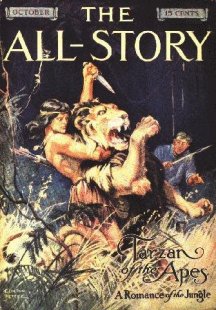 One
of the most memorable fictional characters from literature of any century
that is easily recognizable by old and young alike is Tarzan, another characterization
of Edgar Rice Burroughs. Tarzan of the Apes was written in serialization
form in 1912 and was first published as a book in 1914. Its success spawned
twenty-three additional Tarzan novels and countless film adaptations that
are currently rerun on commercial television at least on a weekly basis.
One
of the most memorable fictional characters from literature of any century
that is easily recognizable by old and young alike is Tarzan, another characterization
of Edgar Rice Burroughs. Tarzan of the Apes was written in serialization
form in 1912 and was first published as a book in 1914. Its success spawned
twenty-three additional Tarzan novels and countless film adaptations that
are currently rerun on commercial television at least on a weekly basis.
Although the character of Tarzan is readily known by students
today this knowledge is based upon what the students have seen rather than
by what they have read. Thus, it is necessary for Tarzan of the Apes
to be included in this unit as a classic adventure-romance that should
be read if only to pay this legendary hero his due respect.
Readers of Tarzan of the Apes will discover the
novel to be somewhat lengthier than At the Earth's Core but no less
entertaining or engrossing. I will not attempt to synopsize events here
but rather will spend some time reasserting the prominence of the entire
series.
Aside from the twenty-four novels in the series there
have been forty-three different film adaptations of the character to date
since Elmo Lincoln starred in a silent version in 1918. Modern film afficionados
should take note that Jaws and Rocky have a considerable gap to close.
In addition, the character of Tarzan has been featured in newspaper comics,
radio programs, and comic magazines.
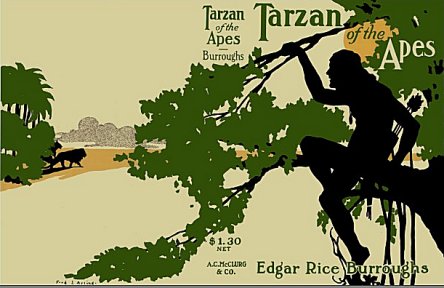 Tarzan
of the Apes and the entire series will forever be the jewel of Burroughs'
achievement. Once again Burroughs creates an imaginary society -- a society
of apes that has its rules and customs. We see our hero from birth assimilated
into this society -- very similar and yet quite different from the tribe.
Tarzan
of the Apes and the entire series will forever be the jewel of Burroughs'
achievement. Once again Burroughs creates an imaginary society -- a society
of apes that has its rules and customs. We see our hero from birth assimilated
into this society -- very similar and yet quite different from the tribe.
We marvel at how Tarzan, the most powerful figure in the
jungle, thirsts for knowledge and develops a working vocabulary through
the books left in his natural parents' cabin when his mother was brutally
attacked by a great ape and his father eventually succumbed to the despair
of his jungle abode.
Tarzan of the Apes is indeed a novel of quest rich
in the epic tradition. It is a novel of boyhood growing into manhood and
a search for an identity that is not easily learned. It is certainly a
novel of survival that ranges from purely savage instincts to the more
intellectual survival techniques of cunning and deceit.
Tarzan of the Apes is also a romance and follows
in every way the epic tradition of a quest for love as evidenced by Tarzan's
infatuation, pursuit, and winning of Jane Parker [Porter].
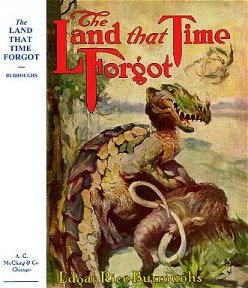 The
Land That Time Forgot is the third book I have chosen to incorporate
in this unit. It is the shortest of the three works and might more appropriately
be termed a novelette as it is the primary part of a trilogy which includes
The
People That Time Forgot and Out of Time’s Abyss. The book features
Bowen Tyler who becomes shipwrecked courtesy of a German torpedo.
The
Land That Time Forgot is the third book I have chosen to incorporate
in this unit. It is the shortest of the three works and might more appropriately
be termed a novelette as it is the primary part of a trilogy which includes
The
People That Time Forgot and Out of Time’s Abyss. The book features
Bowen Tyler who becomes shipwrecked courtesy of a German torpedo.
Bowen rescues a beautiful girl, Lys, from the icy ocean
waters and the two of them eventually wind up on the very same German submarine
that started their troubles. Through the treachery of crew members the
submarine finds itself in the strange land of Caprona that is populated
by prehistoric beasts and primitive societies. Lys is captured and Bowen
Tyler starts his quest to find her encountering a seemingly endless chain
of evolutionary societies.
The Land That Time Forgot is included in this unit
for a variety of reasons. First, it is clearly the best written of the
three works and many critics feel it is the best writing Burroughs ever
achieved.
Secondly, since it is so short and concise, it provides
no substantial barrier to the less avid reader in his quest to read literature
written in epic tradition. Lastly, the series which The Land That Time
Forgot
begins is a shorter series than the Pellucidar or Tarzan novels
and may be read in its entirety quite easily by students who desire to
learn what eventually happens on Caprona.
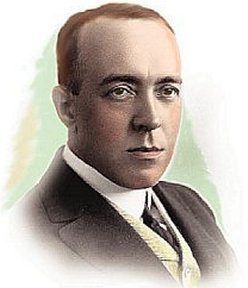 Edgar
Rice Burroughs was born in Chicago in 1875. He was a signal failure
at a variety of careers until he sold his first novel, A Princess of
Mars to All Story Magazine in 1912. All-Story Magazine was one of many
"pulps" that entertained readers from the early 1900s through World War
II. These publications featured fantastic escapist literature written in
serialized form on very inexpensive paper. Their success was immediate
as their acceptance by a young nation of readers not overly interested
in great literature attests. Burroughs used the pulps as his literary outlet
and became an overwhelming success. Avid readers of the pulps enjoyed his
stories beginning with the "Barsoom" series that featured tales which took
place on the Martian landscape. He later followed A Princess of Mars
with Tarzan of the Apes and the rest is history.
Edgar
Rice Burroughs was born in Chicago in 1875. He was a signal failure
at a variety of careers until he sold his first novel, A Princess of
Mars to All Story Magazine in 1912. All-Story Magazine was one of many
"pulps" that entertained readers from the early 1900s through World War
II. These publications featured fantastic escapist literature written in
serialized form on very inexpensive paper. Their success was immediate
as their acceptance by a young nation of readers not overly interested
in great literature attests. Burroughs used the pulps as his literary outlet
and became an overwhelming success. Avid readers of the pulps enjoyed his
stories beginning with the "Barsoom" series that featured tales which took
place on the Martian landscape. He later followed A Princess of Mars
with Tarzan of the Apes and the rest is history.
Burroughs' success rests in the fact that he was a formula
writer who took the same attributes of the epic tradition -- violence,
quest, and romance -- and popularized them in fantastic stories written
to entertain a reading public. Burroughs incorporated hideous creatures
into his stories which were set in strange locations. His literary talent
is that he could paint a fanciful landscape and populate it with an entirely
imaginary species of beings as background for his storyline which was a
hero faced with a multitude of challenges.
Edgar
Rice Burroughs found commercial success as a writer of amazing stories
because he could tell a story in an entertaining fashion. Critics agree
he was not a great writer by any stretch of the imagination. He was a writer
who was -- and still is -- read by countless millions of readers. Therein
lies the success story of Edgar Rice Burroughs. I firmly believe Burroughs
belongs in the classroom. He may not be the center of curricular activity,
but he certainly can awaken the average reader and entertain if only for
a while. My advice to any potential user of this unit is to give ERB a
chance -- swing on a vine and see where he takes you!
The adventure-romance stories created by Edgar Rice Burroughs
and dispensed to the reading public by the pulps offered many readers an
opportunity to forget their personal problems and those of the world. The
success of any adventure-romance depends upon how thoroughly the reader
is able to escape from his present woes or forget, for a moment, the regularity
of everyday routines and immerse himself in another’s adventure albeit
imaginary. Devotees of Burroughs have escaped to the jungles of Africa,
the depths of Pellucidar, and the prehistoric realm of Caprona over the
last seventy years and have returned from these vacations renewed and refreshed
and more able to deal with the realistic concerns of their everyday existence.
An important aspect of adventure-romance fiction is the
notion of conflict. Conflict generally thrusts the hero of an adventure-romance
in a challenge against an antagonist that is either another being, the
environment, or the psyche of the hero himself. These challenges, which
are often coupled with one another within the tale, create the excitement
that is the adventure. Conflict can hardly be seen more clearly than in
Burroughs’ works, which offer new challenges to his heroes with the turning
of each page.
Today’s middle and high school students are faced with
challenges that often become seemingly insurmountable because of their
lack of experience in dealing with them. Oftentimes, a student will ignore
a challenge and remain with the uneasy feeling that if ignored the challenge
will seemingly disappear. Unfortunately, the challenges of life do not
dissipate so readily, and the failure to meet a challenge often spells
doom for one who basks in the comfortable, but tenuous refuge that the
challenge does not really exist or that it will go away.
One particular important challenge for students to confront
is a true assessment of each one’s role in society which is often compounded
and muddled by the pressures of a peer group. Peer group pressure often
inhibits some students in the attainment of goals. As a result a student
finds it increasingly difficult to carve out a niche for himself in society
where he can flourish and realize his true potential. It is true that many
students can and do realize their potential and become contributors to
society in meaningful ways. Some students are goal-oriented from a rather
early age; others become socially conscious only after a period of extreme
disappointment and anti-social behavior. Still others never do reach their
potential and speak forlornly about “should haves” and “could haves”. In
an urban school system these are the students at risk, and their numbers
are certainly staggering to a society that is becoming older and in need
of new, young, and vibrant contributors.
A major emphasis of this unit will be to discuss the societal
challenges highlighted by Burroughs in the primary texts read: Tarzan
of the Apes, At the Earth’s Core, and The Land That Time Forgot.
Their importance in each of these tales is significant as each of the protagonists
must find a successful approach in dealing with them. Tarzan faces the
challenge of being raised by a society of apes. He knows he is different,
and they know he is different. The result is a series of harrowing challenges
that bespeak jealousy and pride. Further into the novel a similar situation
arises when Tarzan encounters the visitors headed by Professor Porter and
highlighted by Jane Porter. Tarzan would appear to have more in common
with this societal gathering and yet the disparity between the jungle man
and the exploration party conjures up memories in the reader of Tarzan's
aforementioned relationship with the apes. The crisis of societal challenges
reaches its apex at the conclusion of the novel when a Tarzan that is somewhat
modified by society searches out and wins the target of his affection on
her maliciously prescribed wedding day.
At the Earth's Core features a more imaginary society
in the setting of Pellucidar for David Innes. David's entrance into this
strange world is more abrupt than Tarzan's introduction to the societies
in his tale. David perseveres and attempts to right the wrongs that to
him are apparent in this subterranean world. Nevertheless, as strange and
unnatural as the Mahars' cruel domination of Pellucidar may seem, this
is a society with customs, rules, and regulations. David sets out to become
a reformer in this society but, in order to do so, he must first change
the way people think. His challenge is one of defeating complacency; he
must combat the blind acceptance of the Mahars by the human slaves of Pellucidar.
Bowen Tyler's societal challenges in The Land That
Time Forgot present an interesting dilemma for him. Tyler is first
faced with the challenge of unifying allies and Germans for the common
good on the German U-boat while at sea and later in the land of Caprona.
Then Tyler faces an even greater challenge as he proceeds up a very inventive
societal ladder of advancement in search of Lys. It is apparent that Burroughs
is telling his readers something as Tyler keeps encountering societies
that are a bit more advanced than the previous ones and, interestingly
enough, that our hero can never seem to retrace his steps.
It is my hope that after in-depth discussions of the various
societies presented by Burroughs in the works read, a larger discussion
can develop in the classroom concerning the challenges that my students
face each day. These discussions will in no way be intended to be prescriptive
but will hopefully encourage students to share various ideas regarding
the solving of these problems. There are no guarantees that students will
willingly participate in such discussions, as the pressure of an ever-present
peer group will be in evidence, but these discussions will be of great
value as starting points for students to write a number of papers. Each
one of the topics for these papers will be student-centered and will touch
upon the various forms of writing that are prescribed in the seventh and
eighth grade language arts curriculum.

Sample Activity #1—The
Journal
The three primary texts for this unit either make mention
of or include a form of journal writing within their pages. Journal writing
helps seventh and eighth grade students feel more at ease with writing.
students experiencing this unit will partake in journal writing while reading
the tales and will continue this activity throughout the year. Students
will be encouraged to write within journals thoughts, opinions, and feelings
regarding a variety of suggested themes. Directed questions and guides
for writing will be of immeasurable assistance to those students who might
otherwise panic when asked to make an entry in their journals during the
early stages of their compilations. As the school year progresses and students
become more accustomed to their individualized writing schema, they will
be afforded more opportunities to write several sentences of their own
accord rather than to respond to teacher-directed suggestions and inquiries.
The journals will be non-threatening in their nature with respect to grading;
entries in the journals will be relevant to presence in class.
An integral importance in the students' writing their
own journals will be the examination of the role that journal writing plays
in Burroughs' works. Journals as a literary vehicle will be studied as
a device which can greatly enhance the telling of a tale as evidenced by
Burroughs' contributions with the implementation of this device.
Sample Activity #2—Pellucidar/Caprona
Reading Edgar Rice Burroughs is an entertaining experience
in large part because the author knew how to describe an entirely imaginary
locale and populate it with creatures that are so inventive that they remain
memorable acquaintances long after the text is put aside. In this activity
students will be charged to create their own Pellucidar or Caprona complete
with inhabitants. The naming of this imaginary land, the description of
its terrain and inhabitants, and the occasion of its discovery will be
left entirely to the student's imagination. More advanced students may
want to tell an entire tale of adventure featuring themselves as the romantic
heroes who are unexpectedly thrust into this strange land of their own
invention. Other students would find it sufficient to merely describe location
and inhabitants paying particular attention to spatial relationships that
are so essential to descriptive writing. In either instance, however, students
will be encouraged to be as inventive as possible in their descriptions.
This writing activity would be best served if introduced
to the students after all reading selections had been completed. Particular
attention should be given to Burroughs’ skill at the creation of imaginary
places and people. Class discussions concerning what Burroughs accomplishes
by his inclusion of a Pellucidar or a Caprona in his tale are of the utmost
importance prior to the assignment of this activity.
Sample Activity #3—The
Quest
This particular activity can be best accomplished either
by classroom discussion, student writing, or a combination of the two.
In essence this activity is at the heart of the unit since it highlights
the quests and challenges of all Burroughs' heroes as an introduction and
background to the challenges each student must face on a daily basis. This
activity can actually be presented several times to students referring
to a wide variety of quests and challenges that are or should be at the
forefront of each student's concern.
One particular quest that each student should explore
in this activity is the notion of a career in future years. Career awareness
is an ever increasingly important aspect of the seventh and eighth grade
curriculum and should be given due consideration in any study of quests
and challenges. All of Burroughs' heroes search or work for a goal within
his novels. Their perseverance in the face of danger and seemingly insurmountable
odds belongs to the same continuum that gives us the epic tradition in
literary history. Students will be encouraged to explore career goals and
explain as best they can the paths that would lead to the successful attainment
of such a goal.
Other activities for class discussion and writing will
include such topics as highlighting the most pressing problems the students
encounter on a daily basis, detailing their views of the most successful
people they have met, and explaining why they admire some people while
understanding why they detest others. Hopefully, the students will be able
to learn from each other during these discussions and more significantly
assess their own relationship within society and their peer group.
I firmly believe that the implementation of this unit
either in its entirety or in part will benefit any seventh or eighth grade
language arts program. Edgar Rice Burroughs is not a particularly difficult
author to read, and the tales he spins are certainly of high interest.
Should the user of this unit wish to eliminate some of the reading involved
any of the three suggested texts would provide ample fodder for the class
discussions and the writing assignments. In any event since all three texts
are the first ones in their respective series, there is little doubt that
the avid reader will pursue other titles in the same series.
The length of time I plan to set aside for this unit will
be from six to eight weeks. This timespan should allow for the reading
of all three novels and for the writing assignments with the exception,
of course, of the journals. Nightly reading assignments will guide the
students and keep the unit on schedule. Class discussions should commence
only after a considerable amount of the reading has been accomplished.

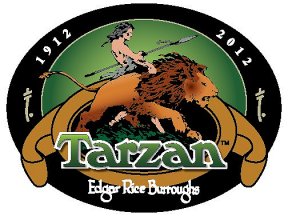
SOME VINES TO SWING ON . . . See ERB
C.H.A.S.E.R. Illustrated Bibliography
BIBLIOGRAPHY
-
Farmer, Philip Jose. Tarzan Alive. Garden City, New
York: Doubleday & Co., 1972. An interesting account that brings Lord
Greystoke to life.
-
Holtsmark, Erling B. Edgar Rice Burroughs. Boston:
Twayne Publishers, 1986.
-
Current and extensive research dealing with Burroughs.
-
Porges, Irwin. Edgar Rice Burroughs: The Man Who Created
Tarzan. Provo, Utah: Brigham Young University Press, 1975. A very comprehensive
view of Burroughs.
-
Reynolds, William J. “Tarzan, Lord Greystoke.” TWA Ambassador
17, no. 4 (April, 1984): 61-67. The impetus for this unit that made entertaining
reading at 40,000 feet. Article highlights the film adaptations of Tarzan.
Light and interesting article.
-
Scholes, Robert and Rabkin, Eric S. Science Fiction: History,
Science, Vision. New York: Oxford University Press, 1977. Good background
reading on the genre that made Burroughs a success.

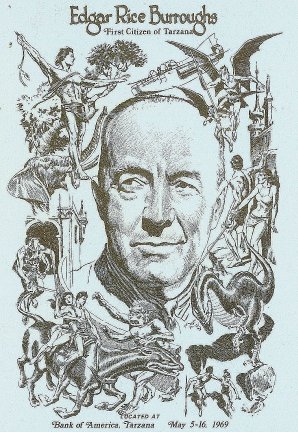
 At
the Earth's Core, a narrative flashback by its central character, David
Innes, will be the highlighted work of the unit. This novel set in the
subterranean depths of Earth, Pellucidar, is a classic example of an adventure
story in the epic tradition. Moreover, it is as fine an example of quest
literature as has been written in the twentieth century, and would probably
make even Homer smile. The tale begins with David Innes, our young, handsome
hero climbing aboard the Iron Mole with its inventor, Dr. Abner Perry.
The Iron Mole is an invention which is in itself a symbol of man's quest
into the unknown, for it was invented to bore through the Earth's crust
in an attempt to discover just exactly what did exist within the confines
of the planet. David and Ferry attempt to perform a test bore; however,
the experiment goes awry and the two plummet deep beneath the Earth's crust
where they discover another world -- a world known as Pellucidar. Shortly
afterward the two men are taken prisoner by strange creatures of this inner
world. It is then that David meets the beautiful Dian -- a very human vision
of loveliness of this inner world who is also a prisoner.
At
the Earth's Core, a narrative flashback by its central character, David
Innes, will be the highlighted work of the unit. This novel set in the
subterranean depths of Earth, Pellucidar, is a classic example of an adventure
story in the epic tradition. Moreover, it is as fine an example of quest
literature as has been written in the twentieth century, and would probably
make even Homer smile. The tale begins with David Innes, our young, handsome
hero climbing aboard the Iron Mole with its inventor, Dr. Abner Perry.
The Iron Mole is an invention which is in itself a symbol of man's quest
into the unknown, for it was invented to bore through the Earth's crust
in an attempt to discover just exactly what did exist within the confines
of the planet. David and Ferry attempt to perform a test bore; however,
the experiment goes awry and the two plummet deep beneath the Earth's crust
where they discover another world -- a world known as Pellucidar. Shortly
afterward the two men are taken prisoner by strange creatures of this inner
world. It is then that David meets the beautiful Dian -- a very human vision
of loveliness of this inner world who is also a prisoner.
 One
of the most memorable fictional characters from literature of any century
that is easily recognizable by old and young alike is Tarzan, another characterization
of Edgar Rice Burroughs. Tarzan of the Apes was written in serialization
form in 1912 and was first published as a book in 1914. Its success spawned
twenty-three additional Tarzan novels and countless film adaptations that
are currently rerun on commercial television at least on a weekly basis.
One
of the most memorable fictional characters from literature of any century
that is easily recognizable by old and young alike is Tarzan, another characterization
of Edgar Rice Burroughs. Tarzan of the Apes was written in serialization
form in 1912 and was first published as a book in 1914. Its success spawned
twenty-three additional Tarzan novels and countless film adaptations that
are currently rerun on commercial television at least on a weekly basis.
 Tarzan
of the Apes and the entire series will forever be the jewel of Burroughs'
achievement. Once again Burroughs creates an imaginary society -- a society
of apes that has its rules and customs. We see our hero from birth assimilated
into this society -- very similar and yet quite different from the tribe.
Tarzan
of the Apes and the entire series will forever be the jewel of Burroughs'
achievement. Once again Burroughs creates an imaginary society -- a society
of apes that has its rules and customs. We see our hero from birth assimilated
into this society -- very similar and yet quite different from the tribe.
 The
Land That Time Forgot is the third book I have chosen to incorporate
in this unit. It is the shortest of the three works and might more appropriately
be termed a novelette as it is the primary part of a trilogy which includes
The
People That Time Forgot and Out of Time’s Abyss. The book features
Bowen Tyler who becomes shipwrecked courtesy of a German torpedo.
The
Land That Time Forgot is the third book I have chosen to incorporate
in this unit. It is the shortest of the three works and might more appropriately
be termed a novelette as it is the primary part of a trilogy which includes
The
People That Time Forgot and Out of Time’s Abyss. The book features
Bowen Tyler who becomes shipwrecked courtesy of a German torpedo.















